2011 FORD SUPER DUTY air suspension
[x] Cancel search: air suspensionPage 224 of 441
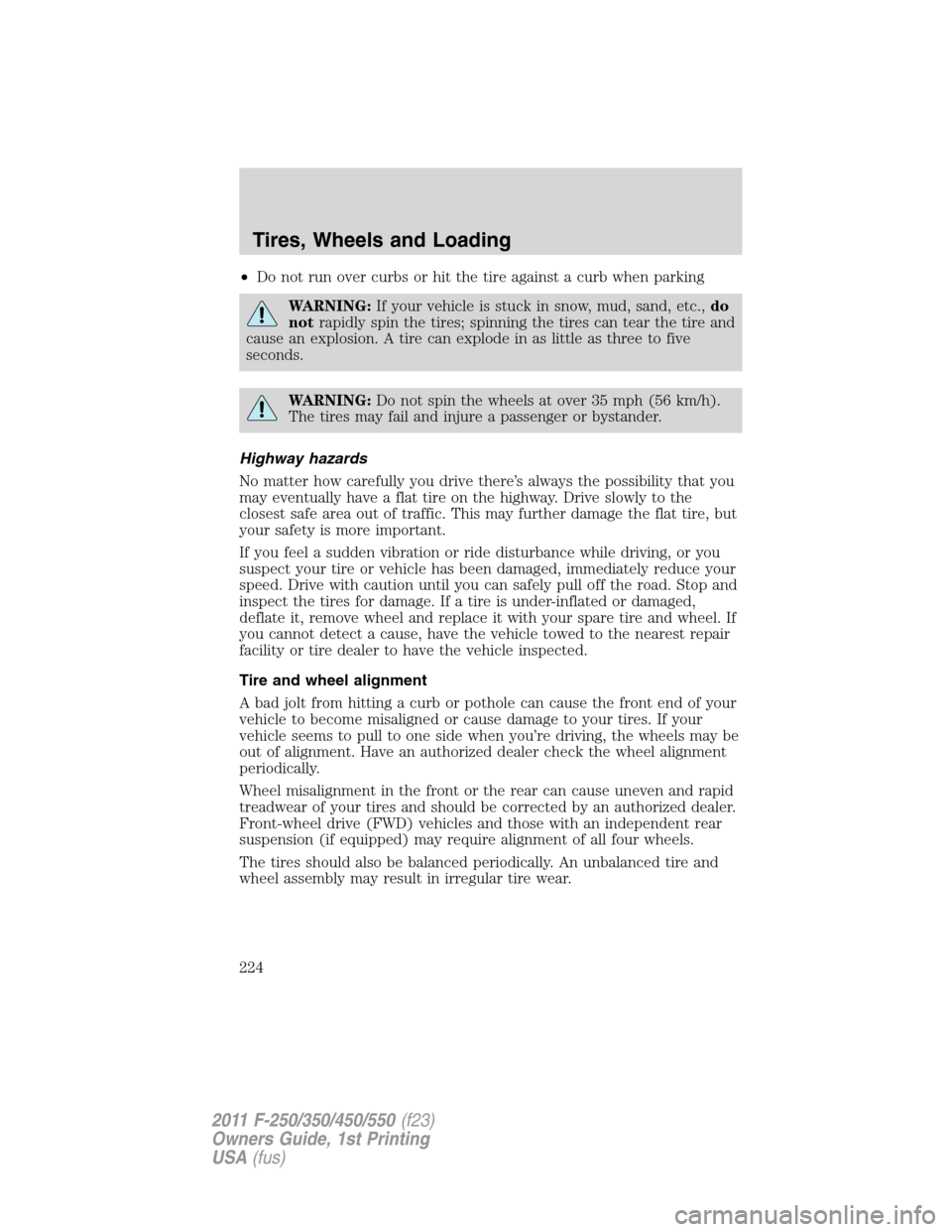
•Do not run over curbs or hit the tire against a curb when parking
WARNING:If your vehicle is stuck in snow, mud, sand, etc.,do
notrapidly spin the tires; spinning the tires can tear the tire and
cause an explosion. A tire can explode in as little as three to five
seconds.
WARNING:Do not spin the wheels at over 35 mph (56 km/h).
The tires may fail and injure a passenger or bystander.
Highway hazards
No matter how carefully you drive there’s always the possibility that you
may eventually have a flat tire on the highway. Drive slowly to the
closest safe area out of traffic. This may further damage the flat tire, but
your safety is more important.
If you feel a sudden vibration or ride disturbance while driving, or you
suspect your tire or vehicle has been damaged, immediately reduce your
speed. Drive with caution until you can safely pull off the road. Stop and
inspect the tires for damage. If a tire is under-inflated or damaged,
deflate it, remove wheel and replace it with your spare tire and wheel. If
you cannot detect a cause, have the vehicle towed to the nearest repair
facility or tire dealer to have the vehicle inspected.
Tire and wheel alignment
A bad jolt from hitting a curb or pothole can cause the front end of your
vehicle to become misaligned or cause damage to your tires. If your
vehicle seems to pull to one side when you’re driving, the wheels may be
out of alignment. Have an authorized dealer check the wheel alignment
periodically.
Wheel misalignment in the front or the rear can cause uneven and rapid
treadwear of your tires and should be corrected by an authorized dealer.
Front-wheel drive (FWD) vehicles and those with an independent rear
suspension (if equipped) may require alignment of all four wheels.
The tires should also be balanced periodically. An unbalanced tire and
wheel assembly may result in irregular tire wear.
Tires, Wheels and Loading
224
2011 F-250/350/450/550(f23)
Owners Guide, 1st Printing
USA(fus)
Page 238 of 441
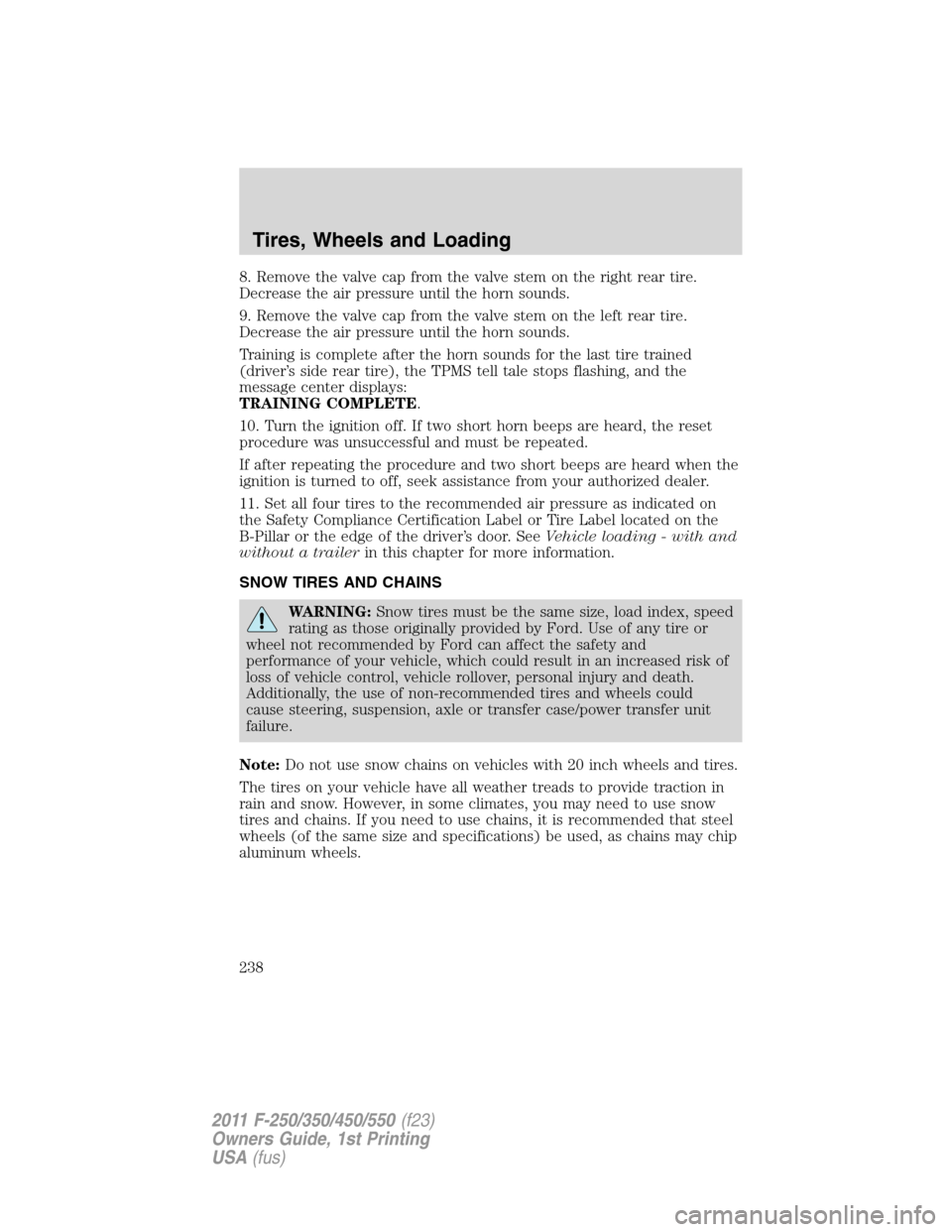
8. Remove the valve cap from the valve stem on the right rear tire.
Decrease the air pressure until the horn sounds.
9. Remove the valve cap from the valve stem on the left rear tire.
Decrease the air pressure until the horn sounds.
Training is complete after the horn sounds for the last tire trained
(driver’s side rear tire), the TPMS tell tale stops flashing, and the
message center displays:
TRAINING COMPLETE.
10. Turn the ignition off. If two short horn beeps are heard, the reset
procedure was unsuccessful and must be repeated.
If after repeating the procedure and two short beeps are heard when the
ignition is turned to off, seek assistance from your authorized dealer.
11. Set all four tires to the recommended air pressure as indicated on
the Safety Compliance Certification Label or Tire Label located on the
B-Pillar or the edge of the driver’s door. SeeVehicle loading - with and
without a trailerin this chapter for more information.
SNOW TIRES AND CHAINS
WARNING:Snow tires must be the same size, load index, speed
rating as those originally provided by Ford. Use of any tire or
wheel not recommended by Ford can affect the safety and
performance of your vehicle, which could result in an increased risk of
loss of vehicle control, vehicle rollover, personal injury and death.
Additionally, the use of non-recommended tires and wheels could
cause steering, suspension, axle or transfer case/power transfer unit
failure.
Note:Do not use snow chains on vehicles with 20 inch wheels and tires.
The tires on your vehicle have all weather treads to provide traction in
rain and snow. However, in some climates, you may need to use snow
tires and chains. If you need to use chains, it is recommended that steel
wheels (of the same size and specifications) be used, as chains may chip
aluminum wheels.
Tires, Wheels and Loading
238
2011 F-250/350/450/550(f23)
Owners Guide, 1st Printing
USA(fus)
Page 306 of 441
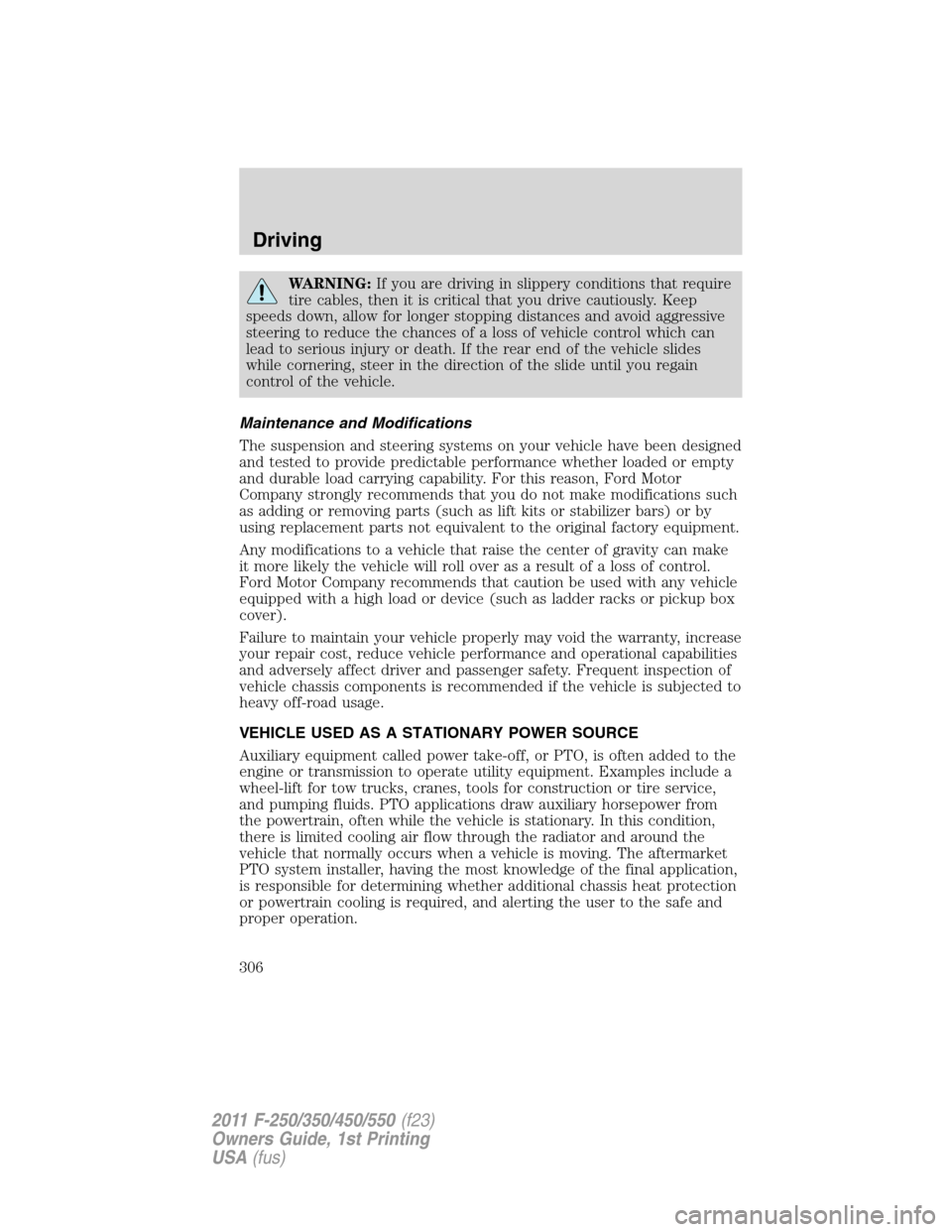
WARNING:If you are driving in slippery conditions that require
tire cables, then it is critical that you drive cautiously. Keep
speeds down, allow for longer stopping distances and avoid aggressive
steering to reduce the chances of a loss of vehicle control which can
lead to serious injury or death. If the rear end of the vehicle slides
while cornering, steer in the direction of the slide until you regain
control of the vehicle.
Maintenance and Modifications
The suspension and steering systems on your vehicle have been designed
and tested to provide predictable performance whether loaded or empty
and durable load carrying capability. For this reason, Ford Motor
Company strongly recommends that you do not make modifications such
as adding or removing parts (such as lift kits or stabilizer bars) or by
using replacement parts not equivalent to the original factory equipment.
Any modifications to a vehicle that raise the center of gravity can make
it more likely the vehicle will roll over as a result of a loss of control.
Ford Motor Company recommends that caution be used with any vehicle
equipped with a high load or device (such as ladder racks or pickup box
cover).
Failure to maintain your vehicle properly may void the warranty, increase
your repair cost, reduce vehicle performance and operational capabilities
and adversely affect driver and passenger safety. Frequent inspection of
vehicle chassis components is recommended if the vehicle is subjected to
heavy off-road usage.
VEHICLE USED AS A STATIONARY POWER SOURCE
Auxiliary equipment called power take-off, or PTO, is often added to the
engine or transmission to operate utility equipment. Examples include a
wheel-lift for tow trucks, cranes, tools for construction or tire service,
and pumping fluids. PTO applications draw auxiliary horsepower from
the powertrain, often while the vehicle is stationary. In this condition,
there is limited cooling air flow through the radiator and around the
vehicle that normally occurs when a vehicle is moving. The aftermarket
PTO system installer, having the most knowledge of the final application,
is responsible for determining whether additional chassis heat protection
or powertrain cooling is required, and alerting the user to the safe and
proper operation.
Driving
306
2011 F-250/350/450/550(f23)
Owners Guide, 1st Printing
USA(fus)
Page 418 of 441
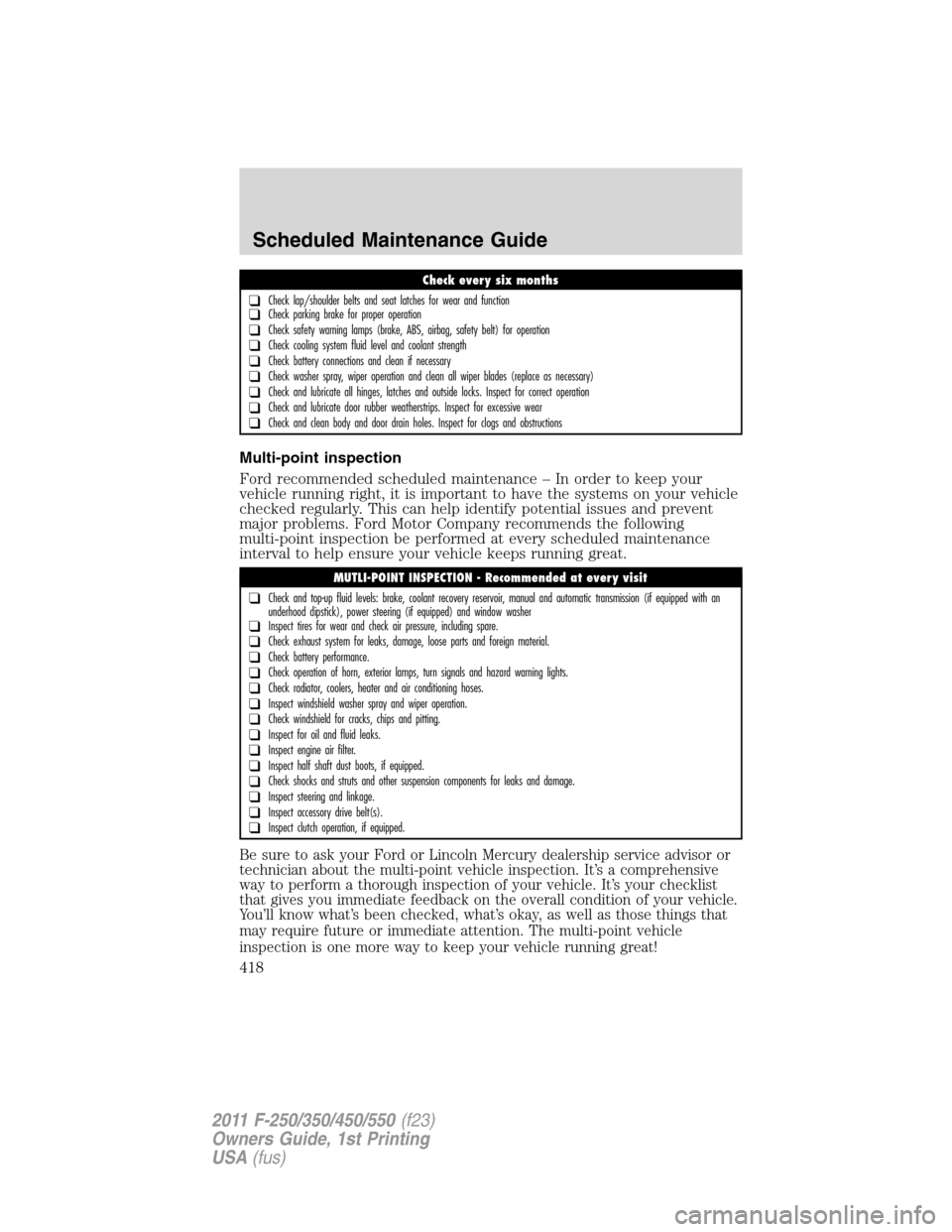
Multi-point inspection
Ford recommended scheduled maintenance – In order to keep your
vehicle running right, it is important to have the systems on your vehicle
checked regularly. This can help identify potential issues and prevent
major problems. Ford Motor Company recommends the following
multi-point inspection be performed at every scheduled maintenance
interval to help ensure your vehicle keeps running great.
Be sure to ask your Ford or Lincoln Mercury dealership service advisor or
technician about the multi-point vehicle inspection. It’s a comprehensive
way to perform a thorough inspection of your vehicle. It’s your checklist
that gives you immediate feedback on the overall condition of your vehicle.
You’ll know what’s been checked, what’s okay, as well as those things that
may require future or immediate attention. The multi-point vehicle
inspection is one more way to keep your vehicle running great!
Check every six months
❑Check lap/shoulder belts and seat latches for wear and function❑Check parking brake for proper operation
❑Check safety warning lamps (brake, ABS, airbag, safety belt) for operation
❑Check cooling system fluid level and coolant strength
❑Check battery connections and clean if necessary
❑Check washer spray, wiper operation and clean all wiper blades (replace as necessary)
❑Check and lubricate all hinges, latches and outside locks. Inspect for correct operation
❑Check and lubricate door rubber weatherstrips. Inspect for excessive wear
❑Check and clean body and door drain holes. Inspect for clogs and obstructions
MUTLI-POINT INSPECTION - Recommended at every visit
❑Check and top-up fluid levels: brake, coolant recovery reservoir, manual and automatic transmission (if equipped with an
underhood dipstick), power steering (if equipped) and window washer
❑Inspect tires for wear and check air pressure, including spare.
❑Check exhaust system for leaks, damage, loose parts and foreign material.
❑Check battery performance.
❑Check operation of horn, exterior lamps, turn signals and hazard warning lights.
❑Check radiator, coolers, heater and air conditioning hoses.
❑Inspect windshield washer spray and wiper operation.
❑Check windshield for cracks, chips and pitting.
❑Inspect for oil and fluid leaks.
❑Inspect engine air filter.
❑Inspect half shaft dust boots, if equipped.
❑Check shocks and struts and other suspension components for leaks and damage.
❑Inspect steering and linkage.
❑Inspect accessory drive belt(s).
❑Inspect clutch operation, if equipped.
Scheduled Maintenance Guide
418
2011 F-250/350/450/550(f23)
Owners Guide, 1st Printing
USA(fus)
Page 420 of 441
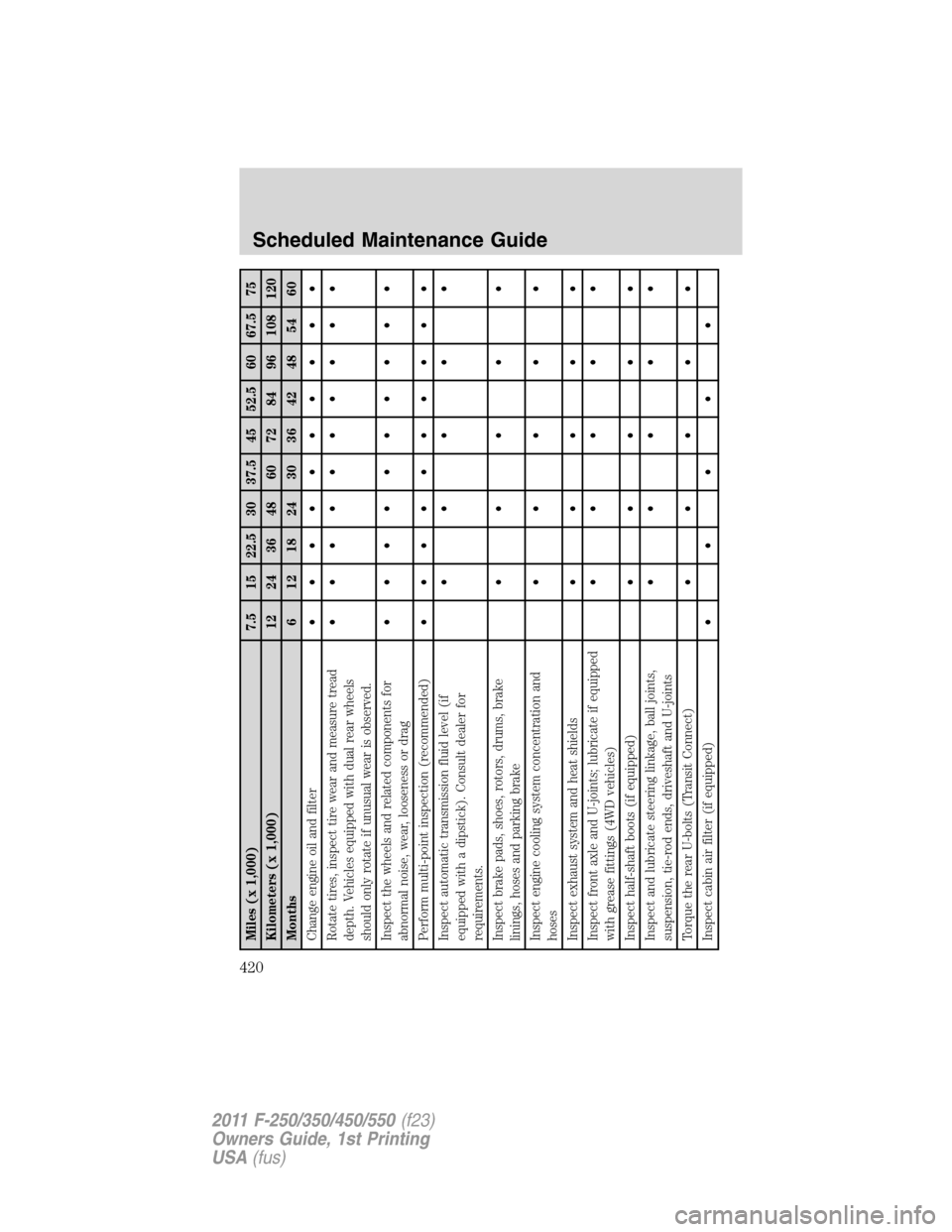
Miles (x 1,000) 7.5 15 22.5 30 37.5 45 52.5 60 67.5 75
Kilometers (x 1,000) 12 24 36 48 60 72 84 96 108 120
Months 6 12 18 24 30 36 42 48 54 60
Change engine oil and filter• •••••••••
Rotate tires, inspect tire wear and measure tread
depth. Vehicles equipped with dual rear wheels
should only rotate if unusual wear is observed.• •••••••••
Inspect the wheels and related components for
abnormal noise, wear, looseness or drag• •••••••••
Perform multi-point inspection (recommended)• •••••••••
Inspect automatic transmission fluid level (if
equipped with a dipstick). Consult dealer for
requirements.•••••
Inspect brake pads, shoes, rotors, drums, brake
linings, hoses and parking brake•••••
Inspect engine cooling system concentration and
hoses•••••
Inspect exhaust system and heat shields•••••
Inspect front axle and U-joints; lubricate if equipped
with grease fittings (4WD vehicles)•••••
Inspect half-shaft boots (if equipped)•••••
Inspect and lubricate steering linkage, ball joints,
suspension, tie-rod ends, driveshaft and U-joints•••••
Torque the rear U-bolts (Transit Connect)•••••
Inspect cabin air filter (if equipped)• ••••
Scheduled Maintenance Guide
420
2011 F-250/350/450/550(f23)
Owners Guide, 1st Printing
USA(fus)
Page 421 of 441
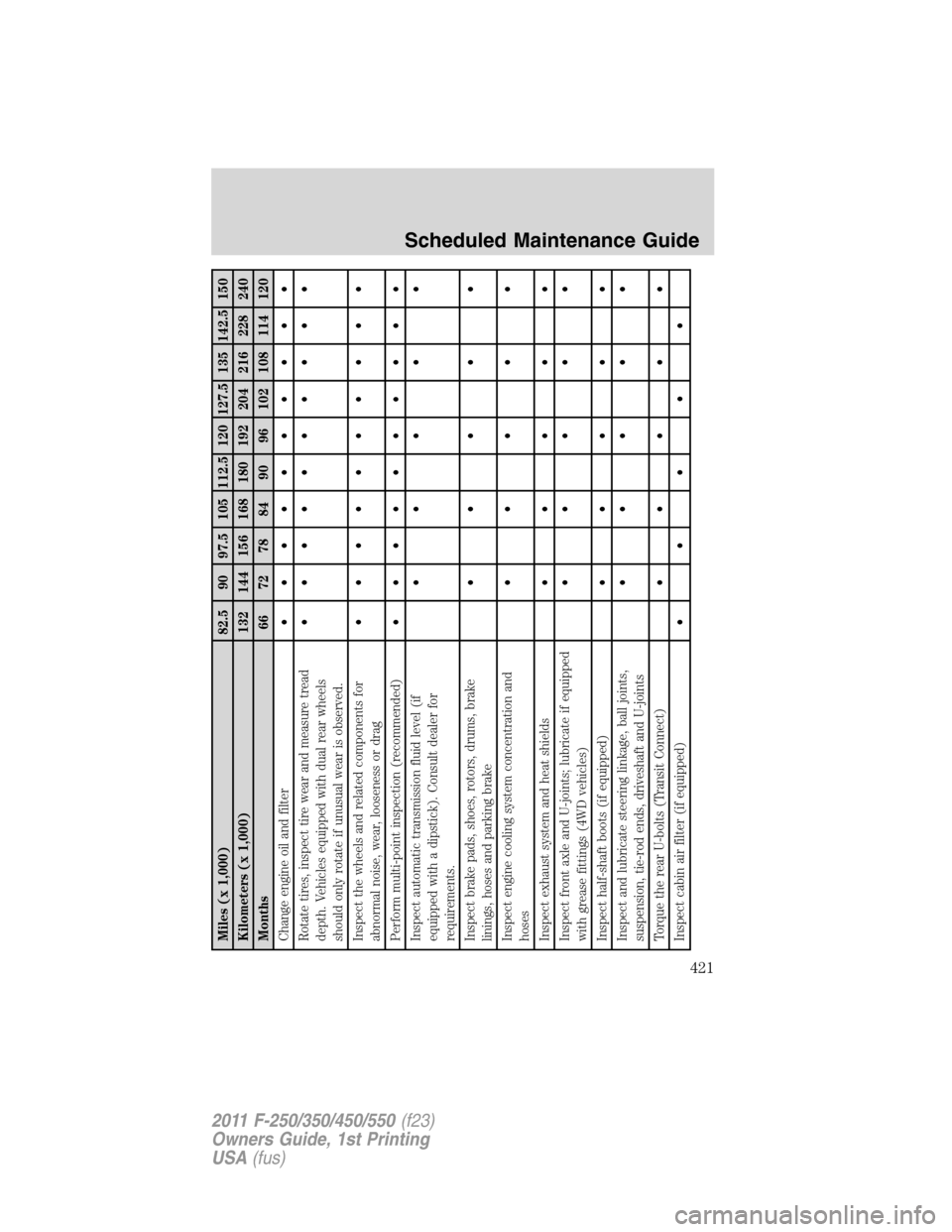
Miles (x 1,000) 82.5 90 97.5 105 112.5 120 127.5 135 142.5 150
Kilometers (x 1,000) 132 144 156 168 180 192 204 216 228 240
Months 66 72 78 84 90 96 102 108 114 120
Change engine oil and filter• •••••••••
Rotate tires, inspect tire wear and measure tread
depth. Vehicles equipped with dual rear wheels
should only rotate if unusual wear is observed.• •••••••••
Inspect the wheels and related components for
abnormal noise, wear, looseness or drag• •••••••••
Perform multi-point inspection (recommended)• •••••••••
Inspect automatic transmission fluid level (if
equipped with a dipstick). Consult dealer for
requirements.•••••
Inspect brake pads, shoes, rotors, drums, brake
linings, hoses and parking brake•••••
Inspect engine cooling system concentration and
hoses•••••
Inspect exhaust system and heat shields•••••
Inspect front axle and U-joints; lubricate if equipped
with grease fittings (4WD vehicles)•••••
Inspect half-shaft boots (if equipped)•••••
Inspect and lubricate steering linkage, ball joints,
suspension, tie-rod ends, driveshaft and U-joints•••••
Torque the rear U-bolts (Transit Connect)•••••
Inspect cabin air filter (if equipped)• ••••
Scheduled Maintenance Guide
421
2011 F-250/350/450/550(f23)
Owners Guide, 1st Printing
USA(fus)